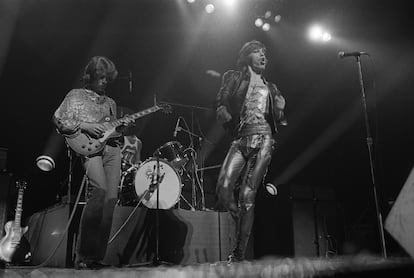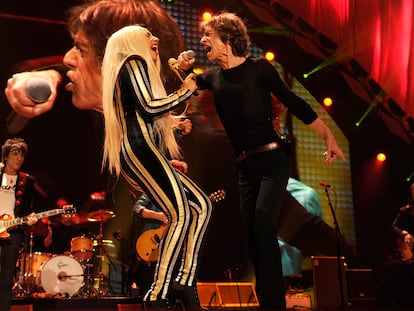Mick Taylor: blues for the ‘forgotten Rolling Stone’
The guitarist was part of the British band when it was at its best, but says he never felt like he belonged

Mick Jagger and Keith Richards had known each other since they were kids in the London neighborhood of Dartford. However, it wasn’t until 1961 when they bumped into each other at a train station that they began to talk about music. Mick happened to have some blues records with him, including one by Muddy Waters. When they decided soon after to form a band, everyone quickly agreed on a name – The Rolling Stones – inspired by the legendary Chicago bluesman’s song, Rollin’ Stone.
More than 60 years have gone by, and after an 18-year break from recording new songs, the Stones just released the better-than-expected Hackney Diamonds. The album features songs that evoke the glory of a band in its prime during the the late 1960s and 1970s. Dreamy Skies, in particular, takes us back to a time when the Stones’ were at their most brilliant.
For a deep dive into their extensive songbook, Amazon Prime Video offers an impressive collection of complete concerts and documentaries featuring the legendary Rolling Stones. Most feature performances from the 21st century, but you can also sample Stones material from tours in the 1980s and 1990s. One standout is Shine a Light, a captivating Martin Scorsese production filmed in 2006 at New York’s Beacon Theater, with special appearances by Bill and Hillary Clinton, as well as guest artists like Buddy Guy and Jack White.
My favorite Stones concert film is their first – Ladies & Gentlemen: The Rolling Stones – recorded during their 1972 tour stops in Fort Worth and Houston. The band was in its prime and had just released the Exile on Main Street double album. The film showcases the remarkable Mick Taylor, a young guitarist whose tenure with the group lasted only five years – but they were arguably the band’s best.
Taylor was a blues guitarist who left John Mayall’s Bluesbreakers to join the Stones after founding member Brian Jones was fired. Although he initially wanted to become a studio or backing musician, his exceptional talent impressed the band enough to put him front and center at their massive concert in Hyde Park on July 5, 1969. It was an improvised tribute performance honoring Brian Jones, who had tragically drowned in a swimming pool two days earlier.
The 20-year-old Mick Taylor was a key figure in cementing the Stones sound after their misbegotten foray into psychedelic rock with Their Satanic Majesties Request. After that, they chose to return to their American musical roots – blues, early rock and a touch of country twang. With the Beatles breakup in late 1969 and a string of hugely successful albums in the early 1970s, the Rolling Stones were undeniably the kings of rock and roll.
This brilliance is on display in Ladies and Gentlemen, a triumphant U.S. tour the Stones turned into a cultural event. At the end of the final concert in Texas, Jagger shows Taylor with confetti in praise. Richards and Jagger may have been prisoners of their addictions at the time, but the band was at its best – live and in the studio. The concerts available on Amazon Prime from the 21st century boast superior filming and editing, but lack the same raw power. The Rolling Stones had spent the better part of two decades touring the world, tirelessly performing their greatest hits over and over again. Their craftsmanship is undeniable, but there’s a sense that routine had set in. But not way back in 1972.
Taylor played a crucial role in creating that sound, but he never quite felt like he fit the Rolling Stone image. In 1974, he decided to leave the band without giving much of an explanation and the rest of his career was much less memorable, even puzzling. Taking his place was Ronnie Wood, perhaps a lesser player but with a much better attitude. Wood is one of three surviving members of the “original” Stones.
Jagger spoke fondly of Taylor in a 1995 interview with Rolling Stone magazine. “He was a very fluid and melodic musician, something we never had and don’t have now – Keith and Ronnie don’t play like that,” said Jagger, acknowledging that some believe the best version of the band included Taylor. Jagger demurred when asked if he thought so too. “If I said Mick Taylor that, it would somehow spoil where the band is now.” He still doesn’t know why Taylor left and assumes that he wanted to try a solo career. He lets it slip that Taylor didn’t get along with Keith, which Richards has denied.
Taylor’s version of the story was a little more vague. He admitted in 2012 to being upset that he hadn’t received any songwriting credit from the Stones, but said that the main reason for his departure was simply, “I guess I just felt like I had enough... I never felt I was gonna stay with the Stones forever, even right from the beginning.” Others have mentioned his desire to break free from the group’s drug culture, which was starting to catch up with him too. The legendary Stones machine rolled on without Taylor, just as it had after Jones was fired and bassist Bill Wyman retired in 1993. It endures even now, following the death of their supremely talented drummer, Charlie Watts. The Stones did invite Taylor to play in their 50th anniversary tour in 2012 and 2013.
The last song on the Stones’ latest album is a Muddy Waters cover: Rolling Stone Blues. It sounds like a farewell, like the closing of a circle. But we’re talking about the indestructible Rolling Stones, so you never know. The great rock band of our time just wanted to be a blues band, but the two were never a contradiction. Waters himself said so in his 1977 song – The Blues Had A Baby and They Named It Rock & Roll. Yes, it’s only rock and roll, but we like it.
Sign up for our weekly newsletter to get more English-language news coverage from EL PAÍS USA Edition
Tu suscripción se está usando en otro dispositivo
¿Quieres añadir otro usuario a tu suscripción?
Si continúas leyendo en este dispositivo, no se podrá leer en el otro.
FlechaTu suscripción se está usando en otro dispositivo y solo puedes acceder a EL PAÍS desde un dispositivo a la vez.
Si quieres compartir tu cuenta, cambia tu suscripción a la modalidad Premium, así podrás añadir otro usuario. Cada uno accederá con su propia cuenta de email, lo que os permitirá personalizar vuestra experiencia en EL PAÍS.
¿Tienes una suscripción de empresa? Accede aquí para contratar más cuentas.
En el caso de no saber quién está usando tu cuenta, te recomendamos cambiar tu contraseña aquí.
Si decides continuar compartiendo tu cuenta, este mensaje se mostrará en tu dispositivo y en el de la otra persona que está usando tu cuenta de forma indefinida, afectando a tu experiencia de lectura. Puedes consultar aquí los términos y condiciones de la suscripción digital.
More information
Archived In
Últimas noticias
Most viewed
- Reinhard Genzel, Nobel laureate in physics: ‘One-minute videos will never give you the truth’
- Oona Chaplin: ‘I told James Cameron that I was living in a treehouse and starting a permaculture project with a friend’
- Pablo Escobar’s hippos: A serious environmental problem, 40 years on
- Why we lost the habit of sleeping in two segments and how that changed our sense of time
- Charles Dubouloz, mountaineering star, retires at 36 with a farewell tour inspired by Walter Bonatti











































